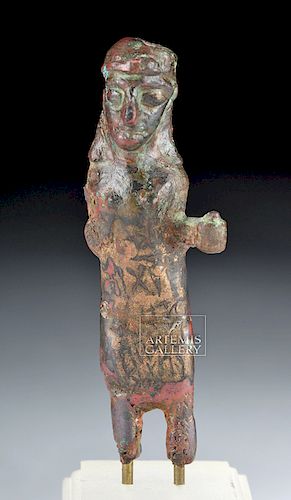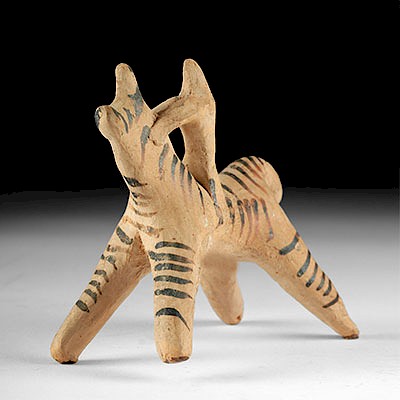Rare Nabataean Bronze Female Votive Figurine
Lot 121a
About Seller
Artemis Gallery
686 S Taylor Ave, Ste 106
Louisville, CO 80027
United States
Selling antiquities, ancient and ethnographic art online since 1993, Artemis Gallery specializes in Classical Antiquities (Egyptian, Greek, Roman, Near Eastern), Asian, Pre-Columbian, African / Tribal / Oceanographic art. Our extensive inventory includes pottery, stone, metal, wood, glass and textil...Read more
Estimate:
$2,200 - $3,300
Absentee vs Live bid
Two ways to bid:
- Leave a max absentee bid and the platform will bid on your behalf up to your maximum bid during the live auction.
- Bid live during the auction and your bids will be submitted real-time to the auctioneer.
Bid Increments
| Price | Bid Increment |
|---|---|
| $0 | $25 |
| $300 | $50 |
| $1,000 | $100 |
| $2,000 | $250 |
| $5,000 | $500 |
| $10,000 | $1,000 |
| $20,000 | $2,500 |
| $50,000 | $5,000 |
| $100,000 | $10,000 |
| $200,000 | $20,000 |
About Auction
By Artemis Gallery
Oct 25, 2018
Set Reminder
2018-10-25 11:00:00
2018-10-25 11:00:00
America/New_York
Bidsquare
Bidsquare : Antiquities from Egypt, Greece, Italy, Asia
https://www.bidsquare.com/auctions/artemis-gallery/antiquities-from-egypt-greece-italy-asia-3538
Featuring Egyptian, Greek, Roman, Etruscan, Near Eastern, plus Asian art from Central and Far East. If you love the classics, this is the sale for you. Artemis Gallery info@artemisgallery.com
Featuring Egyptian, Greek, Roman, Etruscan, Near Eastern, plus Asian art from Central and Far East. If you love the classics, this is the sale for you. Artemis Gallery info@artemisgallery.com
- Lot Description
Ancient Near East, northern Arabia / southern Levant, Nabataean people, ca. 1st century CE. A bronze female figurine, petite in form, standing atop a pair of delineated legs. Constricted shoulders lead downward to one outstretched arm which holds the remnants of an unidentifiable object, and a pair of nubbin bulbs rest in the center of her chest. Her timeless visage is composed of recessed almond-shaped eyes, a prominent nose, diminutive ears, and thin lips, all beneath a simple hat. Noteworthy to this piece are the dozens of Aramaic letters etched into both sides of the torso. This ancient script indicates that she was likely a votive offering bearer or perhaps a priestess. Scattered areas of light-green patina nicely complement the chocolate-hued patina, with areas of russet patina along the verso. Enigmatic and exceptionally rare, this is a fantastic figurine from the ancient Near East! Custom lucite display stand included. Size: 2.625" H (6.7 cm); 4.75" H (12.1 cm) on included custom stand.
The Nabataean kingdom controlled a string of oases that linked trade between southern Arabia (where many forms of incense required for religious worship were created) and the Greco-Roman world, and flourished throughout most of the 1st century CE. The Nabataean sphere of influence extended far into the Arabian Peninsula towards Yemen along the Red Sea. Its capital of Ragmu (present-day Petra) was one of the largest and most highly-frequented cosmopolitan marketplaces in the Near East, though it was only one in a string of Nabataean settlements strung out in an area with very limited resources.
Provenance: private East Coast, USA collection
All items legal to buy/sell under U.S. Statute covering cultural patrimony Code 2600, CHAPTER 14, and are guaranteed to be as described or your money back.
A Certificate of Authenticity will accompany all winning bids.
We ship worldwide and handle all shipping in-house for your convenience.
#132470Losses to one arm, held offering, both feet, small area of top of head, and portion of verso. Repaired at midsection with light adhesive residue along break line. Surface wear and abrasions commensurate with age, fading to facial features and inscribed writing, with some discoloration, otherwise excellent. Light earthen deposits within recessed areas, and nice green, brown, and russet patina throughout.Condition
- Shipping Info
-
All shipping is handled in-house for your convenience. Your invoice from Artemis Gallery will include shipping calculation instructions. If in doubt, please inquire BEFORE bidding for estimated shipping costs for individual items.
-
- Buyer's Premium



 EUR
EUR CAD
CAD AUD
AUD GBP
GBP MXN
MXN HKD
HKD CNY
CNY MYR
MYR SEK
SEK SGD
SGD CHF
CHF THB
THB
















